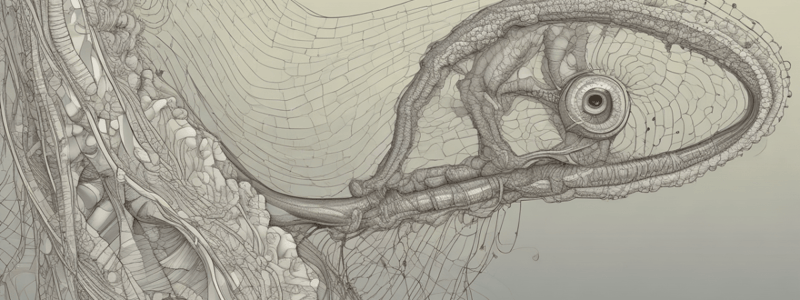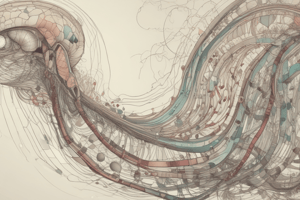Podcast
Questions and Answers
What is the primary difference between sexual and asexual reproduction?
What is the primary difference between sexual and asexual reproduction?
- The number of cells involved in the process
- The complexity of the offspring produced
- The type of genetic material produced
- The number of parents involved in the process (correct)
What is the outcome of asexual reproduction in terms of genetic identity?
What is the outcome of asexual reproduction in terms of genetic identity?
- Offspring are genetically similar to both parents but not identical
- Offspring are genetically identical to one parent (correct)
- Offspring are genetically distinct from both parents
- Offspring are genetically identical to both parents
What is the purpose of cell division in multicellular organisms?
What is the purpose of cell division in multicellular organisms?
- To increase genetic diversity
- To produce offspring
- To adapt to environmental changes
- To grow and repair themselves (correct)
What is the characteristic that defines living things and is ensured by reproduction?
What is the characteristic that defines living things and is ensured by reproduction?
How do offspring produced by sexual reproduction differ from their parents?
How do offspring produced by sexual reproduction differ from their parents?
What is the process by which single-celled organisms produce offspring through asexual reproduction?
What is the process by which single-celled organisms produce offspring through asexual reproduction?
What is the primary difference between asexual and sexual reproduction in terms of offspring genetic identity?
What is the primary difference between asexual and sexual reproduction in terms of offspring genetic identity?
What is the result of meiosis in sexual reproduction?
What is the result of meiosis in sexual reproduction?
Why do children resemble their parents but are not identical to them?
Why do children resemble their parents but are not identical to them?
What is the primary advantage of asexual reproduction?
What is the primary advantage of asexual reproduction?
What is unique about the reproduction of bacteria?
What is unique about the reproduction of bacteria?
What limits the rapid growth of bacterial populations?
What limits the rapid growth of bacterial populations?
Which of the following best explains the increased potential for adaptability in offspring resulting from sexual reproduction?
Which of the following best explains the increased potential for adaptability in offspring resulting from sexual reproduction?
In which of the following scenarios would asexual reproduction be less favorable compared to sexual reproduction?
In which of the following scenarios would asexual reproduction be less favorable compared to sexual reproduction?
What is a key limitation of asexual reproduction in terms of its potential to facilitate evolutionary change?
What is a key limitation of asexual reproduction in terms of its potential to facilitate evolutionary change?
In what type of environment is asexual reproduction often favored?
In what type of environment is asexual reproduction often favored?
What is a key advantage of sexual reproduction in terms of its potential to facilitate evolutionary change?
What is a key advantage of sexual reproduction in terms of its potential to facilitate evolutionary change?
Flashcards are hidden until you start studying
Study Notes
Reproduction Types
- There are two basic types of reproduction: asexual reproduction and sexual reproduction.
- Asexual reproduction produces offspring that are genetically identical to the parent, whereas sexual reproduction produces a similar, but genetically unique offspring.
Asexual Reproduction
- Asexual reproduction is the process of creating offspring from just one parent.
- It involves a single parent and produces a clone, an organism that is genetically identical to the parent.
- Haploid gametes are not involved in asexual reproduction.
- A parent passes all of its genetic material to the next generation.
- All prokaryotic and some eukaryotic organisms reproduce asexually.
- Asexual reproduction can be very rapid, allowing organisms to crowd out other organisms that reproduce more slowly.
Sexual Reproduction
- Sexual reproduction is combining genetic material from two parents, usually from two gametes.
- It produces offspring that are genetically distinct from other offspring and from their parents.
- Meiosis produces haploid gametes that fuse during fertilization to produce a diploid zygote.
- In sexual reproduction, a child inherits half of the genetic material from each parent.
- Sexual reproduction promotes genetic diversity, enhancing adaptation to changing environments.
Advantages and Disadvantages
- Asexual reproduction:
- Accelerates population growth in stable environments.
- Reduces the risk of accumulating harmful mutations in offspring.
- Increases the likelihood of survival in unpredictable or changing environments.
- Disadvantages:
- The absence of recombination and genetic reshuffling during reproduction limits genetic diversity.
- Sexual reproduction:
- Facilitates the generation of genetic variation, providing raw material for natural selection.
- Increases the rate of population growth, leading to rapid adaptation to changing environments.
- Enhances adaptation to changing environments.
- Disadvantages:
- Accelerates the accumulation of deleterious mutations in a population.
- Limits the ability of organisms to adapt to novel environmental challenges.
Ecology and Evolution
- The ecological consequences of sexual and asexual reproduction depend on environmental conditions.
- Sexual reproduction is favored in unpredictable environments where genetic variation enhances survival.
- Asexual reproduction is favored in stable environments where genetic variation is less crucial.
- The ability of organisms to switch between reproductive modes depending on environmental conditions is an adaptation to changing environments.
Studying That Suits You
Use AI to generate personalized quizzes and flashcards to suit your learning preferences.




